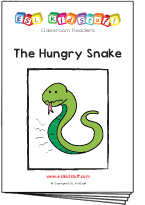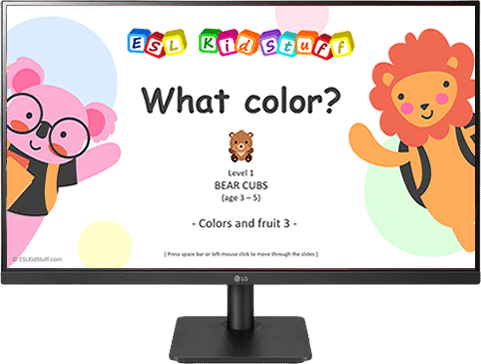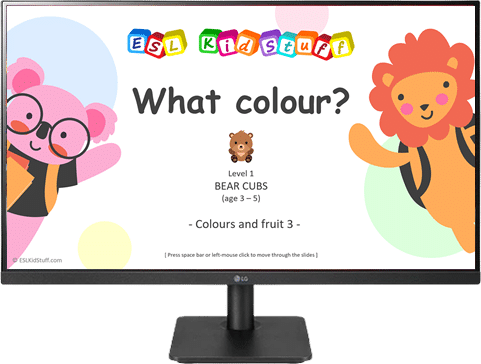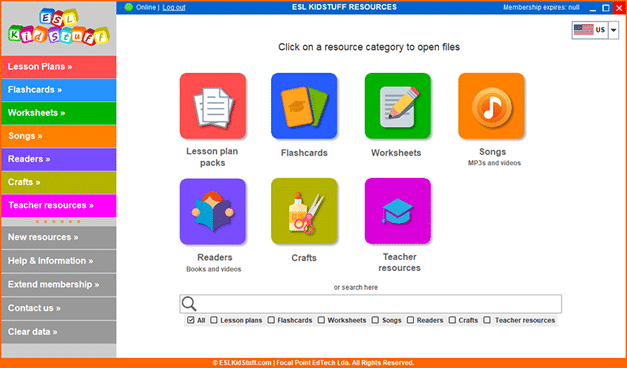Fruit and counting 3 lesson plan
“Yummy!”
Lesson 8 Level 1 Age 3-5
Lesson plans for ESL kids teachers

Lesson 8
Fruit and counting 3
This lesson reviews fruit from last lesson and introduces the numbers 1 to 10. Students learn some new vocabulary, play fun counting games and activities, sing an energetic counting song and taste some real fruit.
Members get accompanying flashcards, worksheets and songs.
Materials:
Our lesson plans are FREE!
Sign up for accompanying:
✔ worksheets
✔ homework sheets
✔ craft sheets
✔ flashcards
✔ PowerPoint lessons & multimedia
✔ song downloads & videos
✔ classroom readers & videos
Click to see lesson details, materials and supplies
Age: 3-5 years
Time: 40 mins – 1 hour
Objectives: Identify and recognize 8 fruit, count to 10, saying fruit you like.
Structures: “What fruit is it?”, “How many are there?”, “What fruit do you like (to eat)?”, “I like …”.
New vocabulary: 7, 8, 9, 10.
Review vocabulary: apple, banana, grapes, orange, melon, pineapple, lemon, strawberry, 1, 2, 3, 4, 5, 6.
Lesson materials
Flashcards:
- apple, banana, grapes, orange, melon, pineapple, lemon, strawberry
Printables:
- Draw the missing fruit worksheet
- Match the fruit worksheet
Songs:
- Hello song
- Goodbye song
- The numbers song
Supplies:
- name tags for each student
- a glove puppet
- [hide_on_uk]colored[/hide_on_uk][hide_on_us]coloured[/hide_on_us] crayons / pencils
- name tracing sheets (one for each student with their name in dots)
- plastic fruit (in a small box)
- a box with objects in to count
- real fruit, cut up into small pieces (for the “Fruit tasting” activity)
- paper/plastic plates, plastic spoons (for the “Fruit tasting” activity)
- cushions (1 per student)
- device to play the songs on
Students count up to 10 and learn an action-packed counting song. They also get to say their fruit likes and dislikes by tasting real pieces of fruit.
Lesson procedure:
Warm up and maintenance:
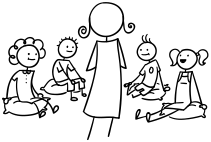
1. Greetings
Greet the students by name as they enter the classroom and gesture for them to sit down (on cushions if you have them) in a fan-shape around you.

2. Name tags
Before class prepare some name tags (stickers or pin-on tags) with each student’s name written on in lower case letters. Sit down with your students and lay out the name tags in front of you. Pick up each tag and call out the name. Try and encourage each student to put their hand up and say “yes”. Hand over the tags and help to pin / stick on.
In later lessons, once your students can recognize their written name, you can have them pick out their own name tags.

3. Glove puppet greetings
Bring out your glove puppet bag and have everyone shout “Hello!“ into the bag until he wakes up and jumps out of the bag. Then model talking to the glove puppet …
Teacher: “Hello”, What’s your name?”
Puppet: “My name is…”.
… and then have the puppet say hello to each student and ask them the same questions.
Finally, go around saying “Goodbye” and “See you” before going back into the bag and back to sleep.
4. Sing the “Hello song”
Sit in a circle and sing the song (clap along or pat knees).
Lyrics for the “Hello song”
Hello, hello,
How are you today?
Hello, hello,
How are you today?
I’m fine, thank you,
I’m fine, thank you,
I’m fine, thank you,
And how about you?
Hello, hello,
How are you today?
I’m fine, thank you,
And how about you?
Gestures for the “Hello song”
These are quite straight forward. First time you play the song do the gestures and encourage everyone to do them with you.
- Wave as you sing the “Hello, hello” parts.
- Gesture to others as you sing, “How are you today?”
- Point to yourself as you sing, “I’m fine, thank you”
- Hand gesture towards another student as you sing, “And how about you?”.

[hide_on_uk]Short sample (members get full-length song):
[/hide_on_uk]
[hide_on_us]Short sample (members get full-length song):
[/hide_on_us]
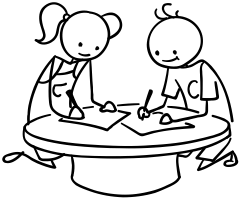
5. Name writing practice
Before class prepare a writing sheet for each student with their name written in dots for them to practice tracing.

Everyone sits at a table with you. Take the sheets of paper and read the names – encourage each student to put their hand up and say “Yes”. Give out the sheets to each student.
Next, say, “Take out your crayons” and have everyone trace their name using different [hide_on_uk]colors[/hide_on_uk][hide_on_us]colours[/hide_on_us]. As the students trace their names, circulate, help and give lots of praise. Be sure to elicit the [hide_on_uk]colors[/hide_on_uk][hide_on_us]colours[/hide_on_us] as a review.
Finally, praise and reward students for doing a good job!

6. Homework check
Check each student’s homework that you set in the last lesson. Ask each student some questions about their homework worksheet (e.g. “How many balloons are there?”), give lots of praise, and then put some kind of mark on the homework sheet (e.g. a sticker, a stamp or draw a smiley face).
Finally, tell your students to put their homework back into their bags.
7. Do “Exercise routine” activity
Say the following and have the students follow your lead:
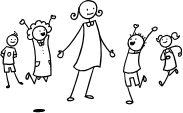
- “Stand up” (Teacher stands and so does everyone else)
- “Hands up / hands down” (do 4 or 5 times)
- “Jump” (4 or 5 times)
- “Kick” (4 or 5 times)
- “Run! / Stop!” (4 or 5 times)
- “Turn around! / Stop!” (4 or 5 times)
- “Wiggle” (a few seconds)
- finally “Sit down”.

8. Review counting 1-6
Sit your students down so they are facing you. Use the plastic fruit or fruit flashcards that you used in your last lesson.
Take 6 pieces of fruit and put each one on the floor / table in front of you in a line. Ask, “How many are there?” and touch each fruit and slowly count with the class “1 … 2 … 3 … 4 … 5 … 6”. Do this two or three times.
Finally, ask one or two students to touch and count the fruit as the rest of the class watches (give lots of encouragement and congratulate them when finished).
9. Do review quiz: How many fruit are there?
Everyone stays sitting where they are. Tell everyone to close their eyes. Place 1, 2, 3, 4, 5 or 6 fruit pieces on the floor and then say, “Open your eyes”. Ask, “How many fruit are there?” and make sure no one shouts out – hands up if they know the answer. Select the student whose hand was raised first for the answer. Then continue with until everybody had a chance to answer.
New learning and practice:
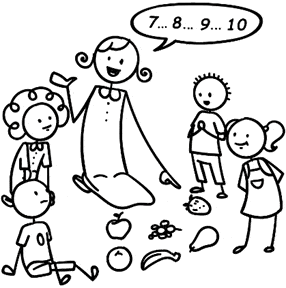
1. Teach counting 7-10
Sit your students down so they are facing you. Use any 10 objects that are small enough to hold, such as plastic fruit, blocks, etc.
Take the 10 objects and put each one on the floor / table in front of you in a line. Ask, “How many are there?” and touch each fruit and slowly count with the class, “1 … 2 … 3 …” to 10. Do this two or three times.
Next, ask one or two kids to touch and count the fruit as the rest of the class watches.
Finally, have everyone sit crossed legged on the floor. Clap and pat knees together at a slow rhythm and chant to 10 as you clap. Each time you reach 10, speed up a little. Keep going until a final, fast and frantic round!
2. Practice counting 1-10
Put the students in pairs and give each pair a number of objects (e.g. 10 plastic fruit, 10 cars, 10 pencils, etc.).
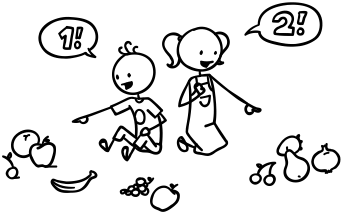
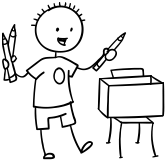
3. Play “Put in the box”
Get a big box of objects and make sure you have 10 objects for each category (e.g. 10 plastic fruit, 10 cars, 10 pencils, 10 blocks, 10 teddies, etc.). Throw the objects all around the classroom. Then choose a student and say, “Put 10 (pencils) in the box”.
As the student picks up each object make sure everyone counts along (1… 2 … 3 … to 10). Then have the student count the objects as s/he puts them in the box. Do this with everyone.
Finally, for a bit of crazy fun, throw all the objects out and let everyone scramble to find, count and put all of their objects back in the box again (all at the same time!).
4. Sing “The numbers song”
Get everyone to stand up and march along and do the actions. Make sure you do the actions with your students so that they can follow you and copy what you are doing.
Lyrics for “The numbers song”
1 – 2 – 3 – 4 – 5 Jump!
6 – 7 – 8 – 9 – 10 Jump!
Turn around and clap your hands
And jump!
1 – 2 – 3 – 4 – 5 Kick!
6 – 7 – 8 – 9 – 10 Kick!
Turn around and clap your hands
And kick!
1 – 2 – 3 – 4 – 5 Wiggle!
6 – 7 – 8 – 9 – 10 Wiggle!
Turn around and clap your hands
And wiggle!
1 – 2 – 3 – 4 – 5 Jump!
6 – 7 – 8 – 9 – 10 Kick!
Turn around and clap your hands
And Jump!
Kick!
Wiggle!
And Jump!
Gestures for “The numbers song”
First time you play the song do the gestures and encourage everyone to do them with you.
- As the music is in a marching-style, start off with everyone marching enthusiastically on the spot to the rhythm.
- Whilst marching, count off the numbers on your fingers as the numbers are sung.
- Do each action word (e.g. jump, turn around, clap your hands, etc.) at the point they are sung in the song.
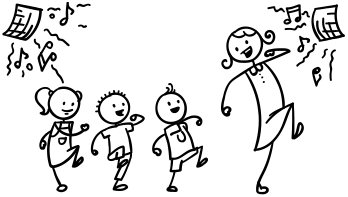
[hide_on_uk]Short sample (members get full-length song):
[/hide_on_uk]
[hide_on_us]Short sample (members get full-length song):
[/hide_on_us]

5. 5-minute play time
This is an optional segment that can be part of all your lessons at this level. Allow your students to play with any games or toys you have. If possible, use large tubs or boxes to hold the toys and bring them out for a few minutes each lesson. Tubs filled with animals, plastic fruit, building blocks, kitchen sets, plastic food, cars & vehicles, Mr. Potato Head dolls and so on.
Encourage your students to ask you for the toy they want to play with, circulate during the play time and ask students about their toys. It’s also a good opportunity for a quick rest room break!

6. Review fruit and structures “What fruit do you like?” and “I like ~“
Sit everyone down and take out your box of plastic fruit and take one fruit out. Elicit the fruit and then say, “Yummy! I like (apples)!”. Put it to your right side. Take another fruit and do the same.
Next, take a fruit and say, “Yuk! I don’t like (melons)”. Put it to your left. Keep going with the rest of the fruit until you have some fruit (likes) on your right and some (dislikes) on your left.
Put the fruit you like in front of you and say, “I like apples, grapes, etc. Then ask a student, “What fruit do you like?”. Encourage him/her to say, “I like …” and list the fruit he/she likes. Go around the class asking each student the same question.
7. Play the “Fruit wall touch” game
Before class print off pictures of the 8 fruit onto A4 paper. Hold up each picture, elicit the fruit and walk around the room taping them to the walls (at a height that your students can reach).
Now model the game: Ask, “What fruit do I like?” and then run around the room touching each fruit that you like saying, “I like ~” as you touch each fruit. Next get all your students to stand up and say to them, “What fruit do you like?”.
Allow them to run around the room touching fruit (encourage them to say “I like~” as they touch).

8. Do “Draw the missing fruit” worksheet
Hold up the worksheet and model the activity: elicit the missing fruit in the first box (an orange). Then draw the orange inside the blank circle and [hide_on_uk]color[/hide_on_uk][hide_on_us]colour[/hide_on_us] it in.
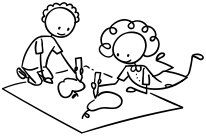
Have your students take out their crayons and complete their worksheets. Spend time with each student, helping, asking questions and praising.
Finally, hold up each student’s work in turn and them to tell you the names of some of the fruit.
Tell your students to put their worksheets into their bags.
9. Do “Fruit tasting” activity
This takes a little bit of pre-class organizing but it’s well worth it – your kids will love this activity!
Buy a piece of fruit for each of the 8 fruits your class has studied. Canned fruit (such as fruit cocktail) will also be fine. If you can’t get all the fruit (out of season) don’t worry, just get as many as you can. Cut the fruit up into tiny squares – try and get all the squares roughly the same size. Put each fruit’s squares on separate paper or plastic plates.
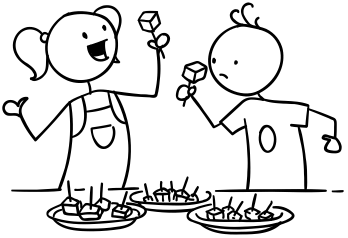
In class, bring the plates into the classroom (don’t have them in the class before this activity as you will never get the students’ attention) and lay them out on a table. Your students have to guess which fruit is on each plate by smelling and eating. If you like you can supply plastic spoons for each student.
Model to the students what to do, though don’t give the game away – make out like you can’t figure out which fruit it is you are tasting and have the students taste and guess with you. Encourage vocabulary such as “Yummy” and “Yuk” and make sure they use the English fruit words and ask them which fruit they like. Good fun!
Wrap up:

1. Assign homework: “Match the fruit”
Hold up the homework worksheet and model matching up the fruit pieces and [hide_on_uk]coloring[/hide_on_uk][hide_on_us]colouring[/hide_on_us] them in. Give out the worksheets and say, “Put your homework in your bags” and help them to do so – this is important as they will probably want to start [hide_on_uk]coloring[/hide_on_uk][hide_on_us]colouring[/hide_on_us] them right away.

2. Say goodbye to the glove puppet
Take out the bag again and get everyone to wake up the glove puppet by shouting its name into the bag (e.g. “Cookie Monster!”). Bring out the puppet and go through the same routine – go to each student and say hello, ask their name and the say goodbye / see you. Then put the puppet back in the bag (back to sleep).
3. Sing the “Goodbye song”
Sit together in a circle and sing and clap along.
Lyrics for the “Goodbye song”

Goodbye, goodbye,
See you again.
Goodbye, goodbye,
See you again.
It’s time to go,
It’s time to go,
It’s time to go,
See you next time.
Goodbye, goodbye,
See you again.
It’s time to go,
See you next time.
Gestures for the “Goodbye song”
These are quite straight forward. First time you play the song do the gestures and encourage everyone to do them with you.
- Wave as you sing the “Goodbye, goodbye” parts.
- Hold your hand above your eyes (as you would when you are looking into the distance and keeping the sun out of your eyes) and look at another student as you sing, “See you again”.
- Tap watch (or imaginary watch) and then point to the door as you sing, “It’s time to go”.
- Point towards another student as you sing, “See you next time”.
[hide_on_uk]Short sample (members get full-length song):
[/hide_on_uk]
[hide_on_us]Short sample (members get full-length song):
[/hide_on_us]

4. Do “Quick check” and say goodbye
Time to leave the class. Make sure everything is put away and the students have gathered their belongings. Have them line up at the door and place yourself between the door and the students.
For each student hold up the worksheet from today’s lesson and ask them some fruit and [hide_on_uk]colors[/hide_on_uk][hide_on_us]colours[/hide_on_us].
When they answer correctly say goodbye and let them leave. If they make a mistake, have them go back to the end of the line – they will have to try again once they reach the front!
Other lesson plans
Levels:
Level 1 lessons (Age 3-5)
Level 2 lessons (Age 5-7)
Level 3 lessons (Age 7-9)
Level 4 lessons (Age 9-12)
Mini lessons (all ages)
Lessons in this level:
- Intro lesson
- [hide_on_uk]Colors[/hide_on_uk][hide_on_us]Colours[/hide_on_us] & fruit 1
- [hide_on_uk]Colors[/hide_on_uk][hide_on_us]Colours[/hide_on_us] & fruit 2
- [hide_on_uk]Colors[/hide_on_uk][hide_on_us]Colours[/hide_on_us] & fruit 3
- [hide_on_uk]Colors[/hide_on_uk][hide_on_us]Colours[/hide_on_us] & fruit 4
- Fruit and counting 1
- Fruit and counting 2
- Fruit and counting 3
- Review lesson: [hide_on_uk]colors[/hide_on_uk][hide_on_us]colours[/hide_on_us], fruit and counting
- Body and shapes 1
- Body and shapes 2
- Body and shapes 3
- Body and shapes 4
- Review lesson: Body, shapes and [hide_on_uk]colors[/hide_on_uk][hide_on_us]colours[/hide_on_us]
- Farm animals 1
- Farm animals 2
- Zoo animals 1
- Zoo animals 2
- Classroom objects and toys 1
- Classroom objects and toys 2
- Classroom objects and toys 3
- Review lesson: Animals, classroom objects, toys
- Our world 1
- Our world 2
- Weather 1
- Weather 2
- Clothes 1
- Clothes 2
- Vegetables and likes 1
- Vegetables and likes 2
- Vegetables and likes 3
- Review lesson: Our world, weather, clothes, vegetables
- Feelings and emotions 1
- Feelings and emotions 2
- Directions
- Wheels on the bus
- Review lesson: feelings, directions, wheels on the bus
Special lessons:
- Christmas lesson
- Halloween lesson
- Easter lesson
- Thanksgiving lesson



